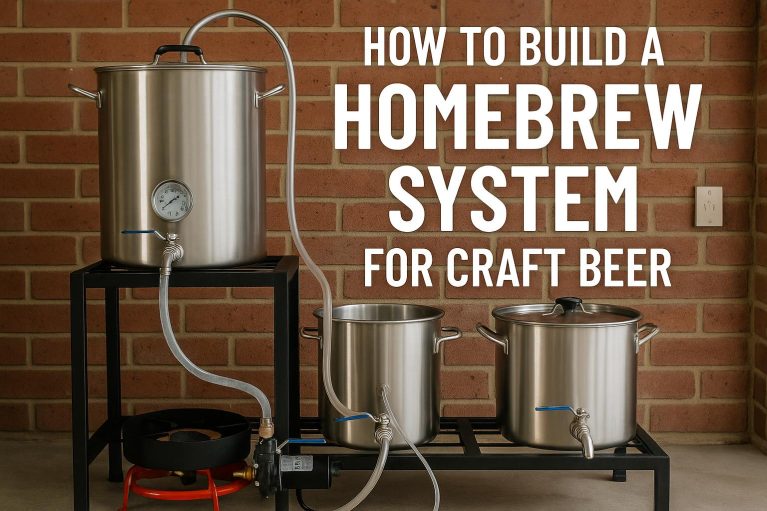Introduction to Homebrewing
Homebrewing has grown in popularity as enthusiasts seek to produce their own craft beer from the comfort of their homes. This hobby is not only engaging but also allows for experimentation with various ingredients and methods, providing an opportunity to produce a beer that suits your personal taste. This guide provides essential information on setting up a homebrew system to kickstart your journey in craft beer brewing.
Essential Equipment for Homebrewing
Understanding and acquiring the right equipment is critical to successful homebrewing. Investing in quality gear will enhance your brewing experience and contribute to the production of better beer.
Fermenter: The fermenter is central to the brewing process, serving as the vessel where fermentation occurs. Options include a plastic bucket, a glass carboy, or a stainless-steel conical fermenter. Each type has its advantages. For instance, glass carboys allow for visual monitoring of the fermentation process, while stainless-steel fermenters offer durability and ease of cleaning.
Brew Kettle: The brew kettle is essential for boiling the wort, which is a sweet liquid extracted from the mashing process. This pot should ideally be made of stainless steel for even heat distribution and to prevent unwanted flavors from leaching into the brew. The size of the kettle should align with the volume of beer you plan to make; larger batches require larger kettles.
Hydrometer: A hydrometer is a crucial tool for measuring the specific gravity of your wort before and after fermentation. By tracking these readings, you can monitor fermentation progress and calculate the alcohol content of your finished beer. Mastery of the hydrometer is key for consistent and repeatable brewing results.
Ingredients for Brewing Craft Beer
At the foundation of beer are four primary ingredients: water, malt, hops, and yeast. Each plays a distinct role in the final flavor and quality of the beer.
Water: Given that beer is predominantly water, its quality has a significant impact on the taste. The water should be free from chlorine and other unwanted minerals. Some brewers opt for filtered water, while others may add specific minerals to achieve a water profile similar to those in famous brewing cities known for particular beer styles.
Malt: Malt, most commonly sourced from barley, provides the fermentable sugars needed for fermentation. Different malts, such as those derived from wheat or rye, contribute to diverse flavors, colors, and textures in the beer. Understanding malt varieties can help you tailor your beer to achieve desired characteristics.
Hops: Hops are integral to imparting bitterness, flavor, and aroma to beer. Varieties of hops are abundant, each offering unique flavors ranging from citrus to floral notes. Researching and selecting the right hop varieties allows you to customize your beer’s profile and achieve a balanced flavor.
The Brewing Process
Brewing involves several stages, each requiring attention to detail. These stages form the backbone of a successful brew day and influence the final quality of the beer.
Mashing: This is the stage where malt is combined with hot water, enabling enzymes to convert the starches in the malt into sugars that yeast will later ferment. The mashing process is typically conducted at a temperature range conducive to enzyme activity and lasts between 60 to 90 minutes. Maintaining a consistent temperature is vital for optimal sugar extraction.
Lautering: Following mashing, lautering separates the sweet liquid, known as the wort, from the spent grains. This involves sparging, where the grains are rinsed with hot water to extract additional sugars. Efficiency during this stage ensures maximum sugar extraction, contributing to better fermentation efficacy and alcohol yield.
Boiling: Boiling serves multiple purposes: it sterilizes the wort, removes volatile compounds, and extracts and alters flavors from the hops. A typical boil lasts for about 60 minutes, with hops added at different times to layer flavors and aromas—early additions increase bitterness, while later additions enhance aroma.
Fermentation and Bottling
After boiling, the process enters a critical phase: fermentation. Proper execution of fermentation and bottling leads to a quality final product.
Fermentation: Post-boil, the wort is cooled rapidly and transferred to the fermenter. Yeast is then pitched, marking the beginning of fermentation. This process generally takes one to three weeks, during which yeast consumes sugars, producing alcohol and carbonation. Temperature control during fermentation is essential, as it influences yeast activity and flavor development.
Bottling: Once fermentation is complete, the beer is carefully siphoned into bottles or kegs. Priming sugar is added to each bottle to fuel natural carbonation. This carbonation phase typically lasts one to two weeks in a dark, temperature-stable environment. Proper sanitation and careful handling during bottling prevent contamination and ensure a safe, enjoyable beer.
Conclusion
Embarking on a homebrewing journey involves a measured investment in both equipment and ingredients. As you explore different styles and refine your techniques, you can produce unique beers tailored to your taste preferences. Like any craft, homebrewing requires patience and attention to detail, but the reward is a personalized beer that reflects your skill and creativity. As you continue to practice and experiment, homebrewing can evolve into a deeply satisfying hobby, blending tradition, innovation, and the joy of experimentation.

